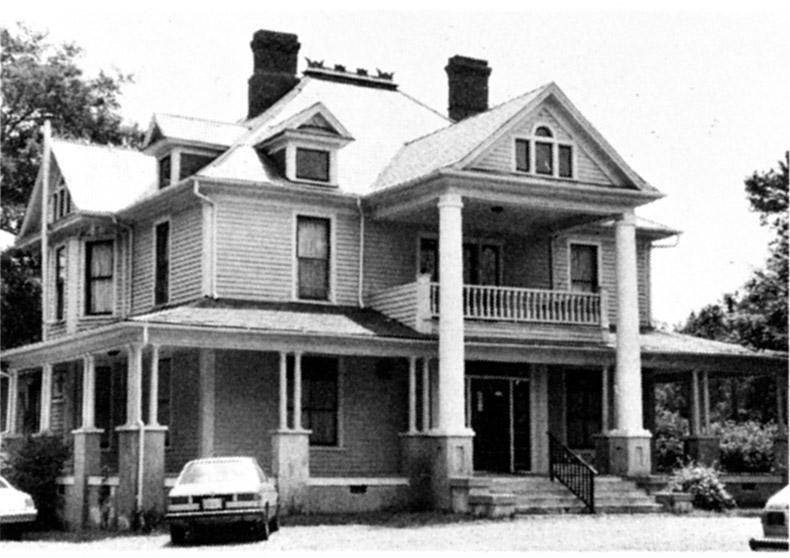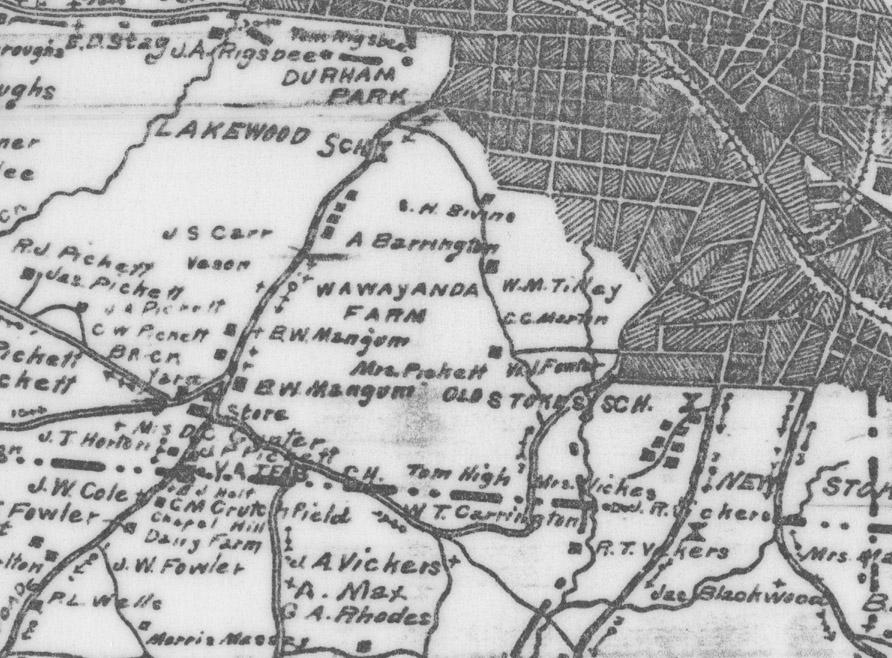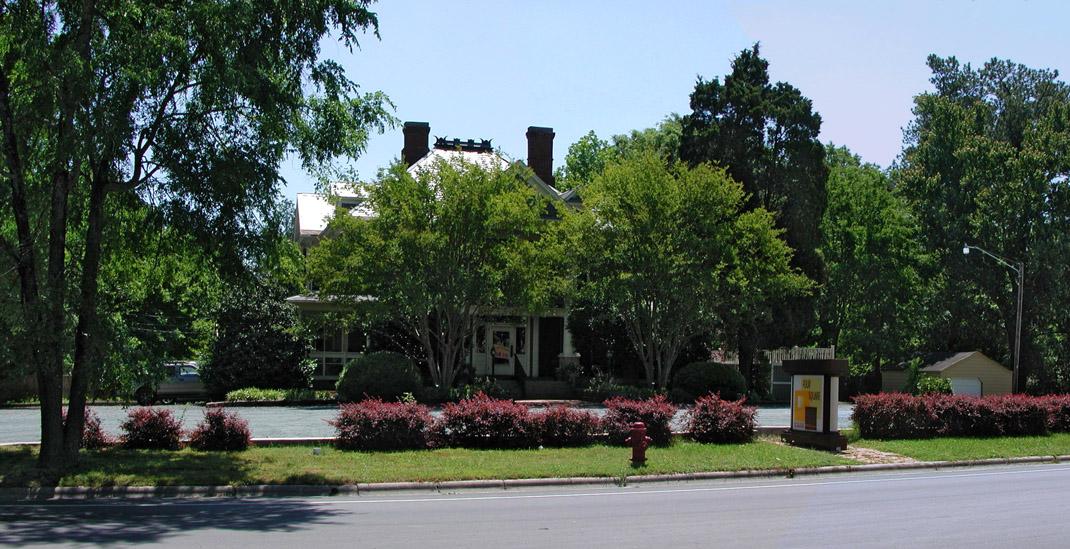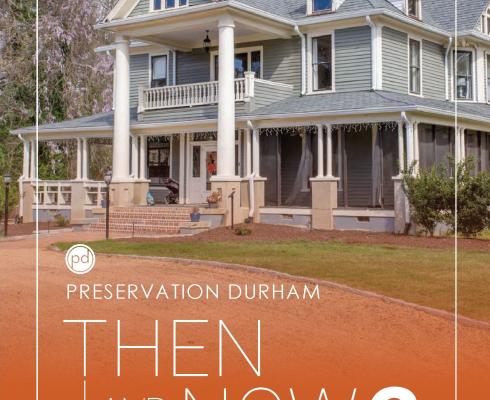One of, if not the most, impressive historic structures remaining in southwest Durham is the house of Bartlett W. Mangum, built in 1908, and once part of a forty-acre tract that included vineyards, as well as a cotton gin, sawmill, and brickyard on the opposite side of Chapel Hill Road. The house was designed and built by William Albert Wilkerson. The farm, along with Julian Carr's Wa-Wa-Yonda farm immediately to the north, were built in the area known as Tuscaloosa Forest.
1910 Map of Durham County, showing predominant landowners along Chapel Hill Road.
(Courtesy Durham County Library / North Carolina Collection)
Mangum lived in the house until his death in 1927; his farm was subdivided and parcels other than an area immediately surrounding the main house were sold off as individual building lots.
From here on out, I'll quote directly from the Four Square website, which may have the best history page of any local restaurant.
"Mangum’s daughters Bessie and Inez lived in the house until 1956 when, at advanced ages, they were moved to a nursing home. It is said that the ghost of one of the sisters still haunts one of the upstairs rooms. The property was then sold at auction and rented for residential purposes until the early 1960’s. From 1960 to 1963, Arthur D. Thomas, who operated a politically ‘alternative’ bookstore in town, used the first floor for a racially integrated, non-denominational church that counted Duke University faculty and area civil rights leaders among its congregants. After Thomas left the area, the house was named ‘Freedom House’ and rented for a time by a civil rights organization. It was used as temporary housing for transient civil rights activists. From 1968 to 1974 the house was operated as a woman’s consignment clothing store called ‘Victoria’s Closet’."
BW Mangum house, late 1970s.
"The house was first used as a restaurant in 1976. Nina Parrish, a Durham native, operated the Old House Restaurant until 1980. From 1981 to 1982 a Chinese restaurant called The Twin Dragon occupied the house. In 1983, the Pless family bought the building and operated it as Claire’s Café until the early 1990’s. The family then leased the building for a number of years before deciding to sell the property in 1999."
Shane Ingram and Elizabeth Woodhouse bought the Mangum house in 1999 and renovated it to open Four Square restaurant. In doing so, they continued/provided a pleasure that isn't common in the Triangle (but was in my native New Orleans) - the restaurant-in-an-old-house. I wish it were more common here as an adaptive reuse for houses that people didn't want to live in; it's part of a broader question as to why old houses weren't converted to retail establishments rather than, for the most part, simply torn down. A row of houses converted to funky retail presents one of the more entertaining and interesting types of streetscapes I've encountered.
BW Mangum House / Four Square, 05.18.08 (Should have captured it during the winter!)
In 2016, Woodhouse and Ingram announced that they were retiring, closing the restaurant on 06/26/16, and putting the building up for sale.
[Update 5/2023] From Preservation Durham Home Tour "Then & Now: Part II"
This house was built in 1908 for early Durham industrialist Bartlett Mangum. Mangum was born in 1857, the son of William Mangum, who had a farm on land that later became Five Points at the center of downtown. By 1884 William Mangum had built several building supply factories on the land, riding Durham’s post-Civil War Durham building boom.
Bartlett Mangum married Sarah Proctor in 1878 and in 1886 purchased 80 acres south of town along the road to Chapel Hill in an area known as Tuscaloosa Forest. He built his own manufacturing works, including a sawmill, planing works, and a brickyard on one side of the road and put in a forty-acre vineyard on the other. By 1893 Bartlett and Sarah had six children, three boys and three girls. He reportedly bought three more acres across the street from the manufacturing complex, and built this house next to the vineyard.
Mangum hired popular Durham contractor William Albert Wilkerson (1851- 1922) to build the house. Wilkerson is probably best known for the house he built for Trinity College President John Kilgo, today known as The Bishop’s House on the Duke East Campus. It is likely that Wilkerson used materials from Mangum’s own factories for the construction of his house. The NeoClassical Revival style exterior has a two-tiered front portico at the center of a wrap-around porch. Two simplified Doric columns support the upper porch roof under a large gable with a multi-pane Palladian window. There are two other similar gables over large bays on each side of the house.
Inside, the details of decoration add elegance to the materials available at Mangum’s works. Although the floors are plain pine boards, the deep wainscoting, pocket doors, and door and window frames have painted faux graining, a popular technique used to upgrade inexpensive wood. The front entry vestibule is divided from the living room with pillared cabinets and the over-door and side-light windows have decorative leaded glass. The staircase has a large newel post and turned rods under the banister.
Each of the eight principal rooms has a fireplace, all built to burn coal and venting up to the two big chimneys. Each mantle has a unique design combining pillars, decorative woodwork, tiles, mirrors, and ironwork hearths. Bartlett Mangum and his wife both died in 1927. Daughter Rosa had married Adolphus Pickett in 1903, and their three sons were also married. Daughters Bessie and Inez continued to live in the house until the mid1950s, when the surrounding acreage was sold off to Claude Adams and other buyers in various parcels. In 1957, their surviving brother Yarborough moved them to a retirement home and sold the family home to Everet and Bettie Frazier. The house was a rental property for some years. Arthur Thomas ran an independent bookstore and lived upstairs in the early 1960s and later the house was used by Durham’s branch of CORE as a meeting place and lodging for traveling civil rights activists. It even served for a time as the headquarters of the local Republican Party.
A clothing store, Victoria’s Closet, occupied the house from 1968-1974. Nina Parrish bought the house and opened the Old House Restaurant in 1975, adding a commercial kitchen addition to the back of the house. After the Old House closed in 1981, she rented the building first to the Twin Dragon Chinese Restaurant and then to Claire’s Café. Claire’s owner Margaret M. Pless bought the house in 1986. The Pless family worked to get the house listed on the National Register of Historic Places, and the plaque was installed on the property in 1989. La Grillade Restaurant opened in 1993 and was soon supplanted by Dominick’s.
In 2000, Elizabeth Woodhouse and Shane Ingram bought the building and opened the Four Square Restaurant. After they closed in 2016, the house lingered for sale as a business property for some years. The current owner had long admired the house when it was Four Square. After the for-sale sign appeared on the property, he thought about buying it as a residence instead of a business and finally contacted a realtor to make an offer. After some negotiation between the realtors and the seller, the proposal to buy the house as a private home was accepted, and the family moved into their new home in 2019.
The current owner’s family live on the lower floor, with the living room and a dining room with a kitchenette on the right side, and two bedrooms on the left. The buyer was very happy to see that, even after so many different businesses in the space over so many years, there had been little change to the interior of the house since the Mangum family had lived here. Much of the original woodwork, fireplaces, windows, and floors- now accented by antique rugs from The Persian Carpet- all remained in place. Even the original handcrank doorbell remained on the side door!
Tourgoers can see the 1975 commercial kitchen addition from the back hall. As the renovation continues, and the space is brought up to modern code by ARC Electric, this space will be turned into a family kitchen and two bedrooms. The two current bedrooms on the main floor will become an office and a playroom.
The owner worked with the Ward Design Group to renovate the upstairs into a two-bedroom Airbnb, accessible from a private cast iron stairway from the left side of the parking area. There is a large open space with two original bedrooms connected as a living room and dine-in kitchen, designed by Kaylor Russell of Kitchen & Bath Galleries of Chapel Hill. Brown Brothers Plumbing and Heating installed a bathroom on the upper floor, which had never had one before! The upstairs has always had its own front porch opening from the central hall, something guests will enjoy on a lovely Durham evening.





Comments
Submitted by gerald (not verified) on Fri, 5/23/2008 - 5:38pm
I took my girlfriend there for her birthday -- I wish I could afford to visit more often. Although I have to say that the house was actually more interesting than the food. I didn't think to ask if they did tours.
Submitted by Anonymous (not verified) on Thu, 12/9/2010 - 3:14am
I remember when it was the Old House Restaurant in the late 70's, run by Nina Parrish. I ate there several times. The food was excellent, the ambiance welcoming, and the house itself was memorable. Thanks for posting the photo and reminding me of a great experience long ago.
Alex Tanford
Submitted by Becca Stone (not verified) on Sun, 11/27/2011 - 3:26pm
Since its located on Chapel Hill Road (directly across the street from La Vaquita aka "the Cow Store") this might fit better in the Tuscaloosa/Lakewood section, especially for those new to the area and trying to get a feel for the neighborhoods.
Add new comment
Log in or register to post comments.